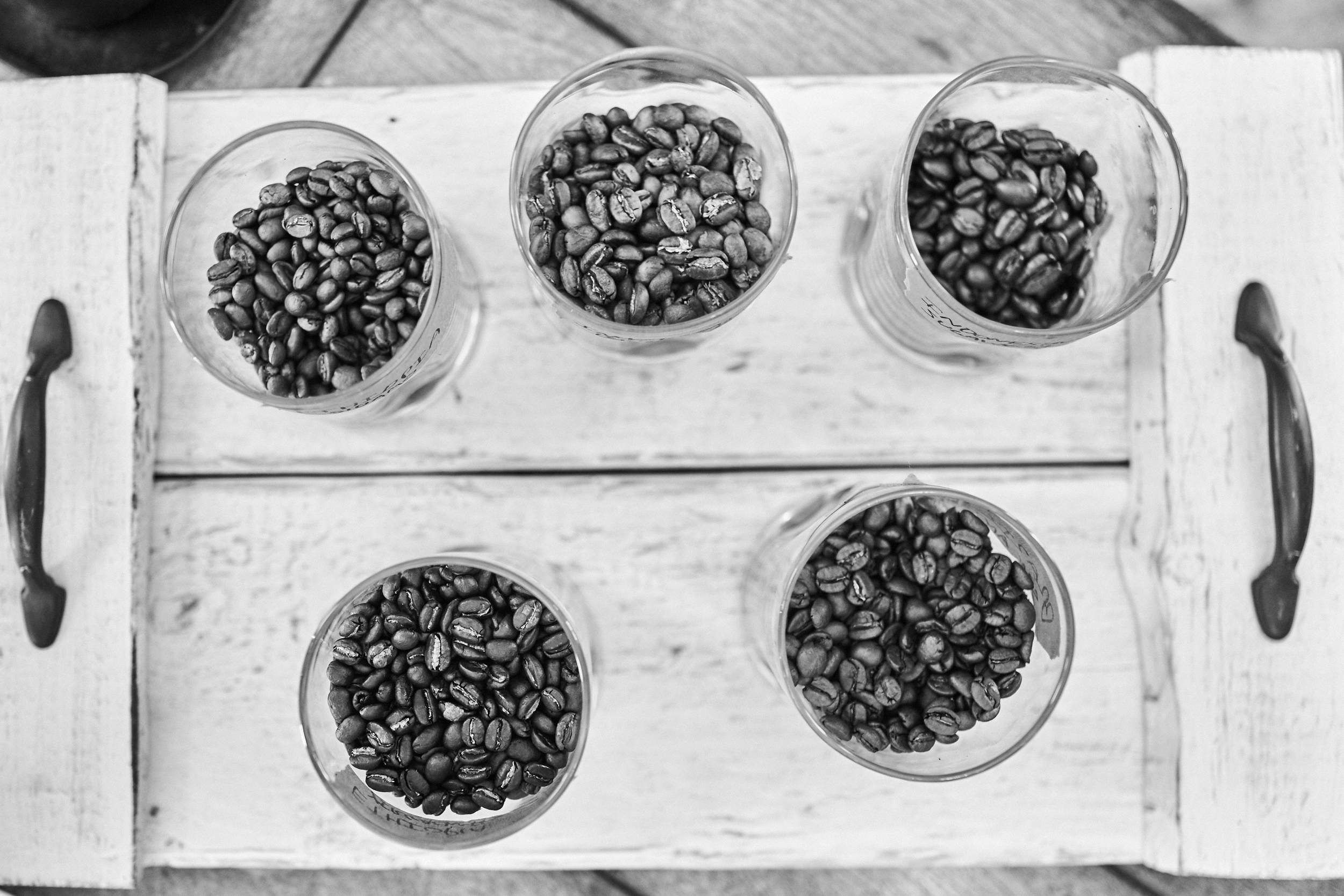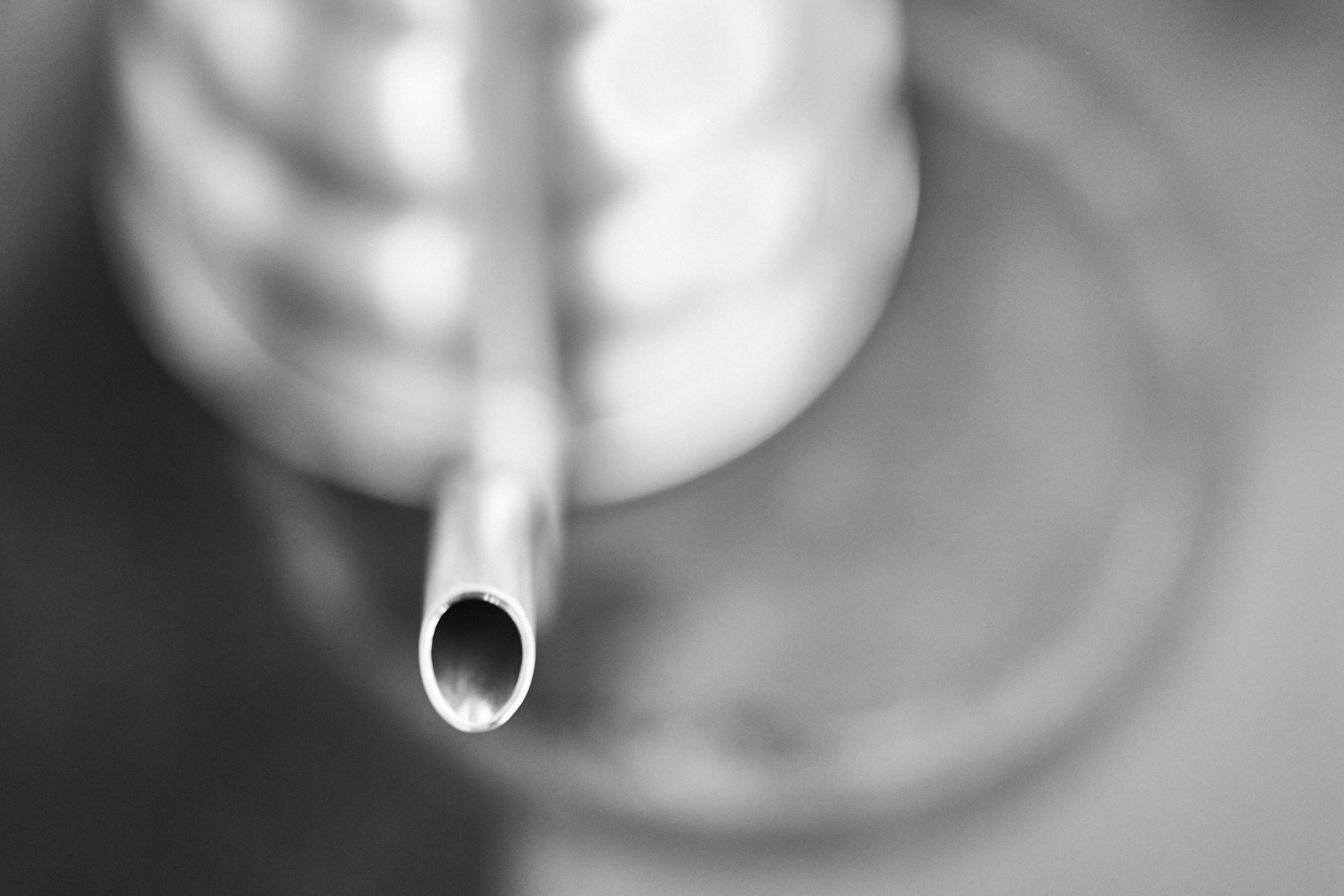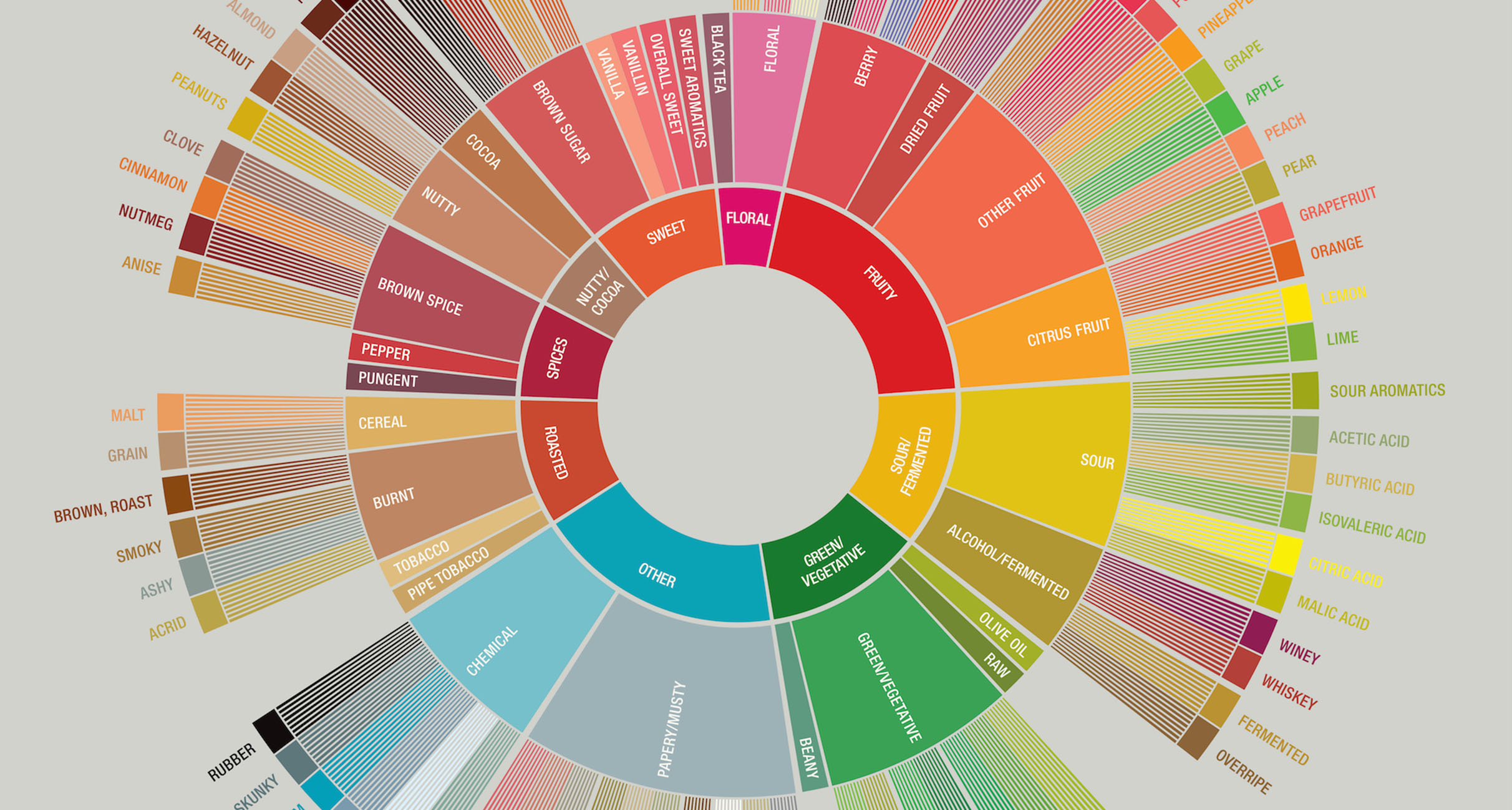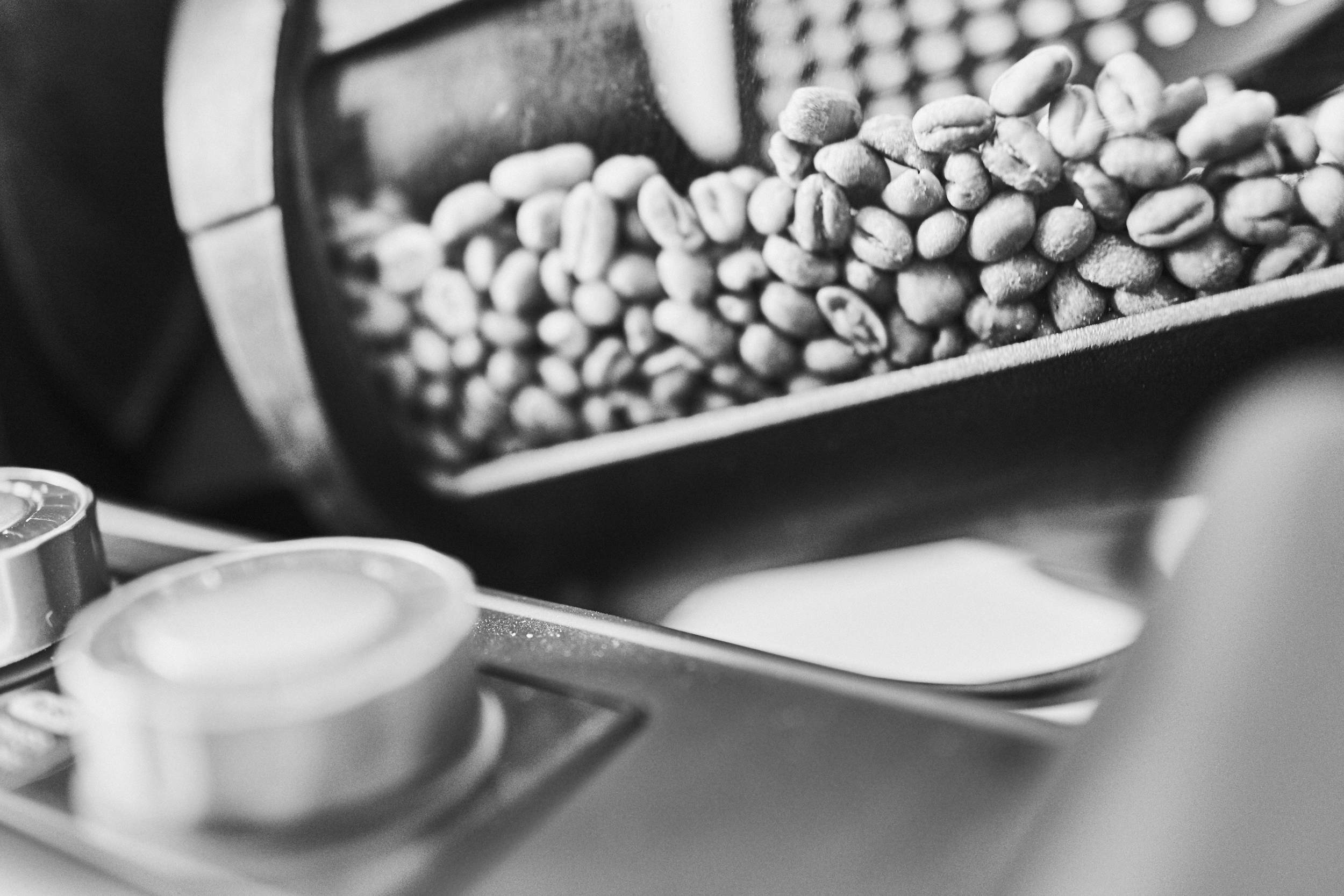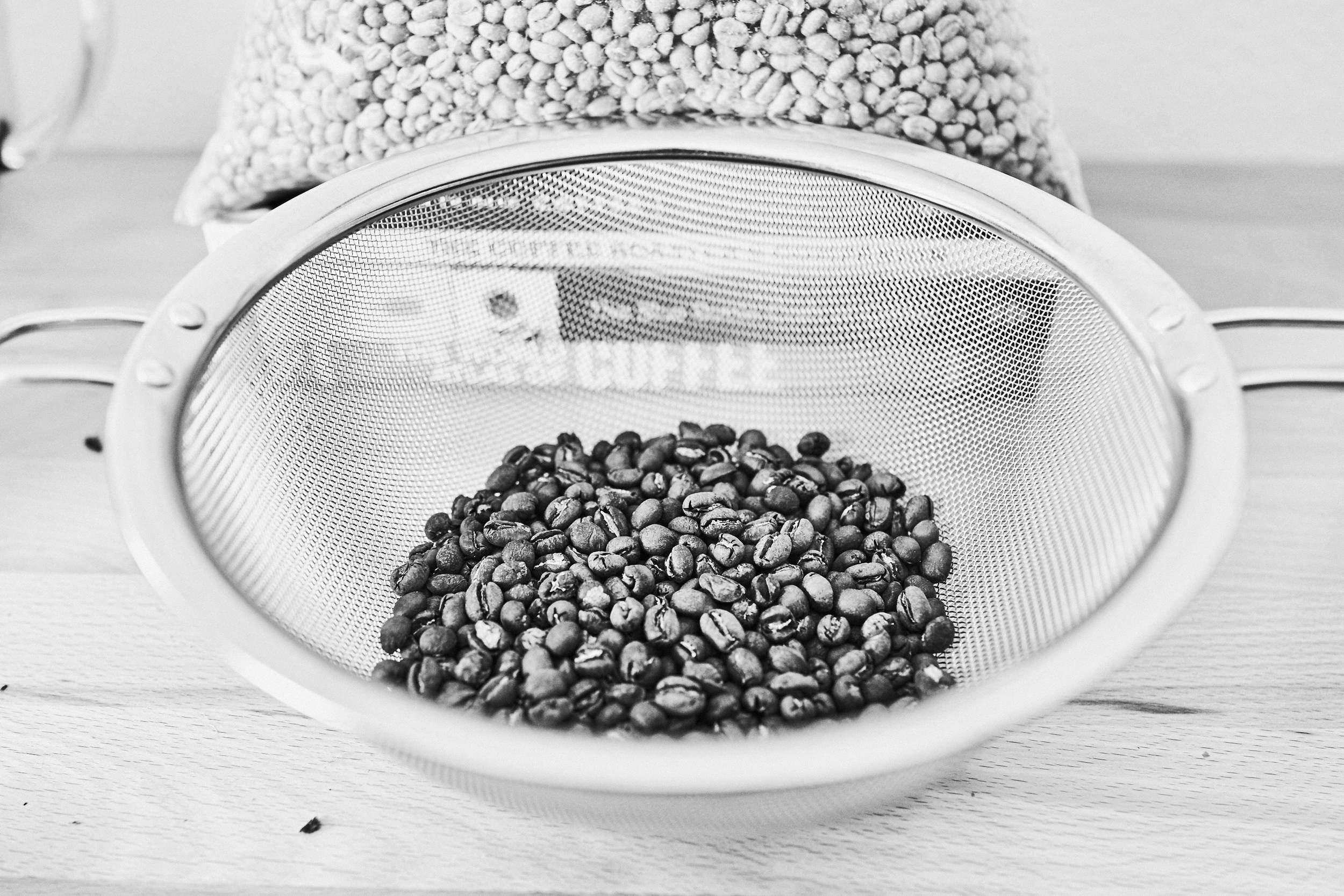A beginner's beginning guide to specialty coffee

March 2016 will mark one year since my friend introduced me to the world of specialty coffee. This article will begin showing you around the metaphorical specialty coffee landscape: the terrain and waterways, the fun people that live on the land, the farmers and merchants, trade organizations, science, DIY culture, media, and even a little politics.
The Places We Are Going
PROLOGUE
WHAT IS SPECIALTY COFFEE, WHERE DOES IT COME FROM?
ROASTING COMPANIES, FASTEST ROUTE TO FLAVOR
BREWING SPECIALTY COFFEE AT HOME
PREFER AUTOMATIC?
WHO IS ORGANIZING THE LANDSCAPE OF SPECIALTY COFFEE?
CUPPING, TASTING
NEWS, REPORTS, BLOGS, PODCASTS
LET'S MEET SOME COFFEE GROWERS
HOME ROASTING
FORUMS, GO TALK, LEARN
SOFTWARE, APPS
CERTIFICATIONS, COFFEE ETHICS
A CHALLENGE TO THE FUTURE OF COFFEE
THE BOOKS
Prologue
If you have only ever bought coffee at the grocery store, or drank coffee from chains like Starbucks and Pete's, and you are interested in exploring the fine world of craft and artisan coffee that brews beyond these usual borders, then this article is for you.
I am writing for you who are nearing or have just crested the ridge line, like me, and are staring down onto a vast new landscape that spreads out before you. If you are like I was a year ago, you are unsure about the way down, the way across, unsure about the new people teeming down there, their language, their traditions, their faiths, the social networks, economies and politics.
I've only been a frequent guest in this new landscape for a few months. But, if you put down your Starbucks cup, I'll show you the way down and into this new landscape. Some explorers have ventured this way long before us. Many people have always lived here. I'll introduce you to some. They will take you further than my introductory jaunt.
As we get down from this ridge and into the new terrain, I advise you that although this is an exciting exploration, we will not be "discovering" anything. We will not tame anything. We are not heroes and heroines in this adventure. We are not conquerors. We are guests. We will humbly introduce ourselves to people and traditions that stretch back thousands of years. And it will be our honor if we are accepted here.
This guide is mostly links to other information, digital introductions, if you will. This guide will only work if you click those links and go meet those other people and read and watch what they have to teach you. I am just here to point you in their direction.
Roasted Coffee Beans (Image by Jeremy Allen)
WHAT IS SPECIALTY COFFEE, WHERE DOES IT COME FROM?
Specialty coffee is not a type, kind, or variety of coffee plant. To me, specialty coffee is a landscape of connected and interdependent people and processes that is focused on quality not quantity of the coffee experience. From farmers, their families, their seasonal workers, quality control processes, the wet and dry milling stations, storage, exporters, importers, commercial and home roasters, cafe owners, baristas, organizations such as the Specialty Coffee Association of America (SCAA), Alliance for Coffee Excellence (ACE), and World Coffee Research (WCR), trainers and educators, universities, sensory scientists, botanists and agronomists, sustainability initiatives, climate scientists, software coders and app developers, equipment and device manufacturers, private and public investors, supply chain and logistics experts, commodities traders, local and national governments, cultural innovators, and more.
When a drop of specialty coffee hits your tongue, you are tasting your connection to the fortunes and misfortunes of everyone in this landscape.
See James Hoffman's amazing book, The World Atlas of Coffee, for detailed descriptions of every coffee producing country, the regions in each country, the types of coffee that grow there, and how those coffees are harvested and processed. I particularly like that he includes some of the political events in each country's past or present that help you understand the coffee industry in that place. Cafe Imports has similar information on their website here. Both of these are great reads! The SCAA has a description of coffee plants here.
The premise behind my entire article is that specialty coffee tastes better than any coffee I've ever had from the grocery store, Starbucks, and Pete's. Let me introduce you to some specialty coffee roasters so you can order beans or visit a cafe right now and taste for yourself. Then we will move on to other parts of the landscape.
Roasting Companies, fastest Route to Flavor
I have tasted from three local specialty coffee roasters in the Denver-Boulder area. Dragonfly Roasters is in Boulder. Corvus Coffee is near downtown Denver. Sweet Bloom is in Lakewood just west of downtown Denver. All three of these roast beans to perfection, and their brews burst with flavors. At Corvus, I met two Baristas, Nathan and Ryan. Nathan brewed two cups for me, one from the Biftu Gudina co-op in Ethiopia and one from the Gakayuni co-op in Kenya. Both were V60 pour-overs and very tasty. Ryan made a cappuccino from Corvus's Everyman blend, a blend of Ethiopian and Guatemalan beans. Best cap I've ever had. I left Corvus with a pretty good buzz. At Sweet Bloom, barista Miguel used a Kalita Wave to brew two cups for me. The first was from the Gitesi washing station in Rwanda. The second a pink bourbon variety from the San Adolfo region of Colombia. Again, these taste better than any store-bought or chain-bought coffee I've ever encountered. From the Dragonfly roasters, I have ordered several bags to brew at home. Their natural-processed Yemen Haraaz was recently ranked by Coffee Review as the number 22 coffee in the country for 2015. And in my opinion it was the best coffee I've had anywhere.
Buy Some specialty Coffee
In addition to those three roasters in the Denver area, Thrillist chose their favorite 21 roasters in the U.S.
- Blue Bottle
- Chromatic Coffee Co.
- Cova Coffee Roasters
- Counter Culture
- Crimson Cup Coffee & Tea
- Cuvee Coffee
- Devocion
- Evocation Micro-Coffee Roastery
- Four Barrel Coffee
- Heart Coffee Roasters
- Intelligentsia Coffee
Tip Time:
Ninety percent of these coffees are light to medium roasts, revealing all the flavors and juiciness of each bean, the hallmark of the specialty coffee landscape. However, many of these roasters also provide medium and dark roasts, done right, to enhance the chocolate, nut, spice, and smoke flavors, without turning the beans to charcoal. In fact, if you have only been drinking Starbucks and Pete's then your palate is already tuned for dark roasts, so you may want start by trying a dark blend from one of these specialty roasters. For more explanation, listen to Stone Creek's podcast episode The Dark Side.
Ponder:
Light does not equal weak! They are features of two different environments.
Dark does not equal strong! They are features of two different environments.
Light and dark are features of the roast resulting from the environment inside the roaster, i.e., the amount of time and temperature inside the roaster.
Weak and strong are features of the drink resulting from the environment inside the cup,i.e., the amount of coffee solids dissolved in the water inside the cup.
French Press (Image by Jeremy Allen)
brewing specialty coffee at home
manual brew
If you just ordered beans from one of these, you'll now want to know how to brew it at home. George Howell's (pretty) brew guides are here. Dragonfly Roasters's brew guide, here, is informative. Blue Bottle has a bunch of brew guides here to help you. Stumptown has brew guides here. Intelligentsia has brew guides here. And Counter Culture has quick and easy versions here. Perfect Daily Grind has brew guides here. There are more! Just let Google and Youtube show you around the brew guide arena.
Prima has a fun rabbit hole if you want eight different ways to brew in just the V60 pour over. Most of the roasting companies mentioned here will also sell you the grinders, scales, kettles, brewing devices, and filters you will need. So after checking out these brew guides, decide which method you want to experiment with first (because their will be others) and buy the gear.
KEY brew CONCEPTS TO GET A HANDLE ON
Freshness
GRIND SIZE consistency
coffee to water ratio
WATER QUALITY
WATER TEMPERATURE
POUR RATE / brew time
EXTRACTION LEVEL
The brew guides will address most of those concepts. Also, the books I recommend at the bottom will cover these concepts in more detail. If you are too lazy, no hate here, to read those brew guides and books, this link will take you to a Hario V60 video brew guide by Matt Perger (I would embed the video here, but it won't work that way, so just follow the link). Then come back and watch this Kalita Wave video brew guide by Nicholas Cho:
No music. No edits. Just the sights and sounds of pourover coffee brewing, and some running subtitled commentary. I've had lots of requests for more in-depth brewing tips for the Kalita Wave dripper, so here you go. Hope it's helpful! For more a more basic introduction to the Kalita Wave dripper, check out my other video: https://vimeo.com/25068779
Tip Time:
You are in a new landscape now, so it is okay to change. Change what? To the metric system. When you buy your brew gear, a kitchen scale will be one item. Make sure it measures in grams. An awesome feature of the metric system is that volume of water in milliliters is equivalent to mass of water in grams. So, for water, 1g = 1ml. When a brew guide says to pour 50g of water into your dripper, you put your dripper on the scale - which will be measuring weight in grams - you then zero the scale and start pouring water. The scale will tell you when 50g of water weight has been added, which is also the same thing as 50ml of water volume! Thank you, metric system.
Also, as elevation changes, the boiling point of water changes. I live in the mountains in Colorado, at 8,200ft. My water boils at 198F (92.2C), which is at the very low end of recommended brewing temperatures. If, in accordance with many brew guides, I let my kettle sit for 30 seconds after boiling before brewing my coffee, the water would be way to cool. In my case, I have to begin brewing immediately when the water boils to ensure a minimum of 198F (92.2C).
Ponder again:
Light does not equal weak! They are features of two different environments.
Dark does not equal strong! They are features of two different environments.
Light and dark are features of the roast resulting from the environment inside the roaster, i.e., the amount of time and temperature inside the roaster.
Weak and strong are features of the drink resulting from the environment inside the cup,i.e., the amount of coffee solids dissolved in the water inside the cup.
Prefer automatic?
Are these manual brew techniques a little overwhelming right now? If so, you can start with one of these SCAA certified automatic brewers. These are certified to heat water to proper temperatures, properly pour it over the grinds, and do it in the right amount of time. This list will change, so be sure to visit SCAA's page to see the latest.
- Technivorm Moccamaster
- Brazen Plus Customizable Temperature Control Brew System
- KitchenAid Coffee Maker KCM0802
- KitchenAid Pour Over Coffee Brewer (model KCM0801OB)
- Bonavita Coffee Maker (model BV1900TS)
- Bonavita BV1900TD 8-Cup Digital Coffee Brewer
- OXO On 9-Cup Coffee Maker
- OXO On 12-Cup Coffee Maker
I have never used one of these automatic drip machines, so I cannot vouch for them. If you have used one of these before, I'd like to read your thoughts in the comments section at the end of this guide. Here is a video of the Technivorm:
Who is organizing the landscape of specialty coffee?
There is the Specialty Coffee Association of America. Think standards, certifications, reports, protocols, education, conferences, competitions, other events, books, and other resources. In their own words:
Established in 1982 by a small group of coffee professionals seeking a common forum to discuss issues and set quality standards for the specialty coffee trade, the SCAA is now the world's largest coffee trade association with nearly 2,500 company members. SCAA members can rightfully be credited for much of the growth and success the specialty coffee industry has experienced over the past twenty-five years.
In fact, I joined the SCAA in February 2016 and immediately registered for two classes in their roasters certification track, CB100 Seed to Cup and CB200 Mill to Roaster. In fact, my friend - the one who introduced to me specialty coffee a year ago - and I have been home-roasting a lot lately and doing our own informal cuppings as we learn the science and SCAA protocols behind roasting and tasting coffee.
There is also ACE, the Alliance for Coffee Excellence. ACE established the Cup of Excellence competitions around the world. Coffees that win the CoE in any given country will frequently sell at high prices at auction, bringing a nice financial reward to the farmers. Here is ACE, in their own words, on the CoE:
Cup of Excellence is the most prestigious competition and award for high quality coffees. The level of scrutiny that Cup of Excellence coffees undergo is unmatched anywhere in the specialty coffee industry. Each year, thousands of coffees are submitted for consideration, with winning coffees sold in global online auctions at premium prices, with the vast majority of auction proceeds going to the farmers.
The competition is rigorous, with cupping evaluations conducted over a three-week process by industry experts: first by a National Jury of about a dozen qualified jurors from the origin country, and then by an International Jury, comprised of approximately 20-25 experienced jurors from around the world. A competition with 300 entries yields an average of 9,000 analyzed cups, with each “Top 10” coffee being cupped at least 120 times.
The Cup of Excellence competition has pioneered integrity and transparency in the coffee industry, ensuring the value of winning coffees.
And there is World Coffee Research. In their own words:
World Coffee Research is a 501 (c)(5) non-profit, collaborative research and development program of the global coffee industry to grow, protect, and enhance supplies of quality coffee while improving the livelihoods of the families who produce it. The program is funded and driven by the global coffee industry, guided by producers, executed by coffee scientists around the world and supported by the Norman Borlaug Institute, part of Texas A&M University.
tip time: Coffee ratings
Want to make sure you are ordering great coffee to drink at home? A couple of ways:
- Go to ACE's page for previous winners of the CoE. Select a country. View the competition results to see which farms produced winning beans. Click on each result if you want to see a detailed list of data about each farm and its beans. Head to Google to find out which coffee roasters are selling coffee from those farms.
- Also, Coffeereview.com has been cupping and evaluating coffee since 1997. Their evaluations, ratings, and rankings are online.
If you are roasting beans at home, you can search for online shops, local cafes, and importers where you can buy green unroasted beans that come from CoE winning farms or that rank highly on Coffee Review. Many of the importer's websites will have a schedule that shows you when beans from any country reach ports in the U.S.. Here is screenshot of the harvest and shipping schedule on Intercontinental Coffee Trading's website:
Here is a similar schedule from Cafe Imports. Keeping checking back with the people who make these schedules because the can change year to year as the climate changes, diseases affect plants, etc.
To wrap up this section on coffee organizations, here are few more. The Barista Guild of America. The Roasters Guild. For coffee more broadly than just specialty coffee, in the U.S., there is the National Coffee Association. Europe has the Specialty Coffee Association of Europe. And there is a list of even more organizations here. And even more here at the Tea and Coffee Trade Journal.
So, as you explore the landscape of specialty coffee, if you get disoriented, you can always reach out to one of these organisations for advice and to get your bearings. I am sure there are important organizations I have not encountered yet, so please mention others in the comments.
cupping, tasting
Now you have read the brew guides, bought your brewing kit, beans, and have brewed your first cup of specialty coffee at home. You may have even looked into some of the coffee organizations for more in-depth information. But how do you describe this epiphany in your mouth? What are these flavors? Lucky for me and you, the SCAA and WCR collaboration produced a new sensory lexicon and flavor wheel:
Download the lexicon here. Purchase the flavor wheel here. As of February 9th, the new flavor wheel posters are not available. But you can download the jpg image, enlarge it in Photoshop and print an 8.5x11 inch version for your personal use. Then check back with the SCAA in March and purchase a poster-sized wheel for your wall. Counter Culture Coffee has their own version of the flavor wheel (2013) if you are interested.
Don't forget to look at SCAA's guide and protocols to cupping. Cupping is the formal practice of tasting and evaluating coffee. It's different from just brewing a cup of coffee, so, really, check out the protocols. Coffee is cupped many times throughout the supply chain. Farmers, producers, exporters, importers, buyers, and roasters all cup coffees multiple times from harvest to service in a cafe.
Cafe Imports follows SCAA protocols but has developed scoring sheets unique for each type of coffee processing, i.e., washed, natural, etc. Get their sheets here.
If you are not cupping your coffees, then you probably are missing key insight into what you are importing, roasting, and serving.
key sensory concepts to get a handle on
aroma
acidity
body
flavor
aftertaste
News, Reports, Blogs, Podcasts
In the specialty coffee landscape there are a many sources of news and information that I have found helpful so far. There are certainly many that I am missing, so please mention your favorites in the comments section. Here are mine. (kiss your roommates, spouses, and children goodnight before entering)
- Sprudge
- Sprudge Wire
- Specialty Coffee Chronicle
- Coffee Hustle
- Barista Hustle
- The Perfect Daily Grind
- Coffee journalist Jim Sherfey
- Roast Magazine
- Barista Magazine
- Tea and Coffee Trade Journal
- Daily C Market price and news articles at Investing.com
- USDA Foreign Ag Service GAIN Reports
- Example Ethiopia annual report
- Example Market Brief Update
Tip Time:
Those podcasts contain episodes that discuss nearly every concept and topic I have mentioned so far in this guide. So, please check out those podcasts, and you will hear discussions that will take you so much further into the specialty coffee landscape than I can do here. There are great interviews with very influential people all across the landscape.
Nearly every entity mentioned so far in this entire article has a website, Facebook page, Twitter feed, and Instagram account. Tap into their various social media feeds to really get your finger on the pulse of what is happening in the landscape. On their websites, sign up for their email newsletters. In your podcast app, subscribe.
Let's Meet Some Coffee Growers
This is the most exciting section for me. I wish I had more than three interviews to share. If you know of more, please link to them in the comments.
- Here is a great interview with Wilford Lamastus, a fourth-generation producer on the Lamastus Family Estates in Panama. Check out the show notes for links to his website and social media
- Here is a great interview with Jose, a coffee producer in Costa Rica. The interview focuses on direct trade relationships. See Stone Creek's episode titled Coffee Sourcing: Direct Relationships. The interview starts at 15:53
- Another Stone Creek interview with a coffee producer, Giorgio, from Finca San Jeronimo in Guatemala.
Tip Time
More than once, these producers mention the important role of social media in helping them connect to coffee buyers. Many producers are on Instagram and post great photographs from coffee farms.
Home Roasting
It's a blast, but it's not easy, and you may not achieve the same flavors produced by the roasting companies listed above. Most of the bean providers listed below also sell the roasters, but not all the roasters. The roasters not sold by the bean providers have their own link.
Home Roasters
- Fresh Roast SR700
- Hottop
- Gene Cafe
- Behmor 1600+
- Quest M3 (only at Coffee Shrub)
- Hucky 500T (only at Crop to Cup)
- Sonofresco Air Roaster (only at Coffee Shrub)
- Bullet R1 (most beautiful of all, but still in production)
- This 500g gas roaster from Mill City
- My YouTube playlist of roasters
Roast Guides
There are so many variables that effect roasting that I cannot list them here. And I don't yet understand them all myself. The most enlightening guide I have seen so far is Scott Rao's book, The Coffee Roaster's Companion. He promotes three commandments of coffee roasting (you really need to read the book in order to get a handle on these, just reading them here may do more harm than good):
Thou Shalt Apply Adequate Energy at the Beginning of a Roast
The Bean Temperature Progression Shalt Always Decelerate
First Crack Shalt Begin at 75% to 80% of Total Roast Time
Black Bear Micro-Roasters has a brief and good guide to their roast theory, here. They also stress Rao's first commandment, but in their own words:
There is a metaphor, "thermal momentum", in the roasting business that is crucial for a person roasting coffee to grasp. If you don't get enough heat into the beans early, there is no way you can make up for it later...
Sweet Maria's has an archive of roasting discussions popular among home roasters, here. Coffee Review has a roasting guide on their site, but I'll point you specifically to this short section on the way they see two major differences in roasting styles.
I have roasted a few decent batches at home on an old Fresh Roast Plus 8 that my friend gave me. This thing only has one control, time. No temp control. No air flow control. I drilled into the top of it and added a K-type thermocouple probe that extends down into the beans so I can monitor the temperature of the beans as best as possible. And I can influence temperature in a few ways: quickly alternating between the heat and cool setting, covering the exhaust at the top of the roaster, adding a homemade insulation layer around the glass roasting chamber, and altering how many beans I put in the chamber.
All of this is really asking too much of this tiny roaster. But it is a lot of fun, and it keeps me engaged with many of the roasting variables so I can experiment. Here is a screenshot of some of the roast stats I gathered on a recent unsuccessful roast of a natural processed Yemen Haraaz. I think these roasts failed for at least two reason. I didn't add sufficient heat in the beginning, breaking one of Rao's commandments. Also, I either went too long in the stages before first crack, or I didn't go long enough after first crack. This broke another of Rao's commandments, that first crack occur between 75-80% of the roast cycle. These roast stats of mine are good examples of what not to do! See Rao's book for better ways!
Some of the roast stats I gathered on a recent unsuccessful roast of a natural processed Yemen Haraaz.
Fresh Roast Plus 8 (Image by Jeremy Allen)
Forums, go talk, learn
Software, Apps
- Coffee Nerd (brew guide app, Android)
- Cropster (roasting and shop app, Apple)
- RoastLog (roasting and shop app, Web app)
- Roastmaster (roasting and shop app, Apple)
- Artisan (free cross-platform desktop roasting app)
- Roast Logger (free cross-platform desktop roasting app)
- RoastWatch (roasting app, Apple)
- MicrRoasters (roasting app, Android)
- Roaster Dynamics (profiling, data logging, control system)
As I keep saying, there are probably important ones I missed, so please mention your favorite phone and desktop apps in the comments.
Certifications, coffee ethics
Fair Trade International. Fair Trade USA. Fair Trade Organic. Bird Friendly. Rain Forest Alliance. Direct Trade. Direct Development. Relationship Coffee, UTZ. And more! There is so much complexity and contention here. This guide is a good place to start. Another is Ethicalcoffee.net. Be sure to follow their links out to other discussions.
In 2011 Fair Trade USA split from Fair Trade International. From what I understand, Fair Trade International wants to certify only democratically organized co-ops, not privately owned farms and plantations, i.e., wage labor. Fair Trade USA disagreed and wanted to offer certifications to private entities as well.
The current popular trend among the roaster's websites I've looked at seems to be the direct trade model, where roasters form relationships directly with coffee farmers and import their beans, leaving out certifying organizations like Fair Trade International and the others. Here is Intelligentsia's statement on their direct trade model. Episode two of the I Brew My Own Coffee podcast discusses direct trade. Temple Coffee just introduced their transparency model called Return to Origin. Here is SCAA's discussion of direct trade. In that discussion, Molly Laverty, now Manager of Sustainable Green Coffee Supply & Procurement for Coffee Bean International, Specialty Coffee by Farmer Brothers, describes direct trade like this:
While there is no official definition of direct trade, the roasters who are actively participating in the buying model share similar principles. These principles focus around coffee quality, supply chain transparency, farm and regional stability, tiered pricing (based on quality), sustainable practices, and consumer education.
From fair trade to direct trade everyone claims to have the interest of the farmer and sustainability in mind and claim to pay the farmers higher sums than they would otherwise get and to help protect environments, with direct traders usually paying farmers even more than fair trade certifications. But it really is more complex than that. Read up for yourself and see what you think. Leave links to other discussions in the comments so we can all get up to speed here. Pricing and socioeconomic models are not the only challenges to coffee justice and the future of coffee.
A Challenge to the future of coffee
This major study published in 2015 outlines the ways climate change will affect environment suitability for Arabica coffee by the year 2050. Here is an excerpt from the abstract:
We modeled the global distribution of Arabica coffee under changes in climatic suitability by 2050s as projected by 21 global circulation models. The results suggest decreased areas suitable for Arabica coffee in Mesoamerica at lower altitudes. In South America close to the equator higher elevations could benefit, but higher latitudes lose suitability. Coffee regions in Ethiopia and Kenya are projected to become more suitable but those in India and Vietnam to become less suitable. Globally, we predict decreases in climatic suitability at lower altitudes and high latitudes, which may shift production among the major regions that produce Arabica coffee.
The researchers explain how the climate will affect each coffee growing region around the world. Here is an example from their discussion of Central America:
Higher temperatures would move the climates suitable for Arabica coffee from the current 400–2000 masl to 800–2500 masl. Nicaragua and El Salvador, which do not have high mountains, would be most affected. Guatemala, Mexico, Honduras, and Costa Rica would gain suitability at elevations 1500–2500 masl, which could compensate in part for losses at lower altitudes. Land at higher altitudes is often forested, so that we expect increased land-use pressure on high-altitude forests [14]. Mesoamerica would confront an average decrease in the area suitable for Arabica coffee up to 30%, with largest losses for Mexico (29%) and smallest losses for Guatemala (19%)
But it's not all bad news, so read the study and see it was says for your favorite coffee growing regions.
The Books
I know you have other books in mind, too, so please leave more book recommendations in the comments below.
